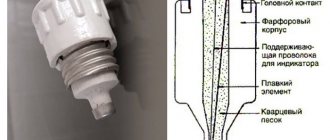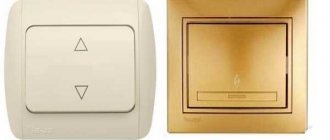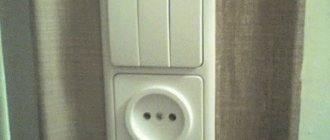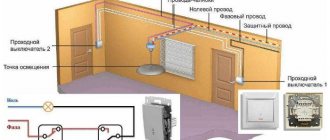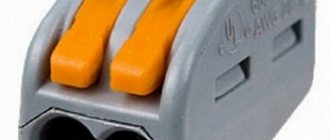A switch with a brightness control (another name is a dimmer) is a device designed to adjust lighting parameters. The device allows you to change the light brightness levels from 0 to 100% of the nominal value.
Dimmers can be used as a replacement for a regular switch, while having significantly greater functionality.
Models
There is a wide range of dimmers on the market, which are classified according to different criteria:
- according to the operating principle;
- on the nuances of the design;
- llama compatibility;
- control equipment.
Thermostatic
The lighting was regulated by changing the resistance. As the indicator increases, the current decreases, the lighting dims and vice versa.
This device is characterized by simplicity of design, but different manufacturers have their own components and build quality. Such indicators are important for stable operation and smooth running. The operating principle of thermostat dimmers is to convert light energy into heat. This will not reduce your electricity costs.
Triac dimmers
Devices based on a triac are more modern dimmers. In order for the lamp to light, a current must pass through the device; a voltage is created between the electrodes. The capacitor is charged by potentiometer R, which changes the phase angle.
When a certain value is reached, the triac opens and current flows through it. The resistance drops and the light bulb burns more intensely. The process is effective with any half-waves - positive and negative, so it does not matter where the flow of electrodes goes. Unlike rheostat models, this option is not protected from flicker due to its design.
Dimmer and lamp compatibility
Select dimmers to match the installed lamps.
Almost any device is suitable for halogen models operating on standard voltage. When the voltage decreases, the color of the light flux changes. Minimum levels result in a reddish tint, which is harmful to the eyes.
If the devices are halogen with a voltage of 12-24 V, it is worth looking at the option with a step-down transformer.
Devices for adjusting low-voltage light sources are sensitive to voltage surges, which will lead to a shortened service life.
If the transformer is electronic, then choose a dimmer marked C.
For fluorescent lighting sources, a special device is provided, which is designed to convert the supply frequency of 20-59 kHz. This approach allows you to influence the current strength, as well as the brightness of the light bulbs.
The pulse width modulation method is used to control LED lamps. The power of the light flux is regulated by the duration of the pulses. High frequency prevents lamps from flickering.
Marking of dimming devices
The marking determines the purpose of the devices and their compatibility with lamps:
- The device marked R is suitable for monitoring light in incandescent lamps with Ohm or Resistive loads.
- The L marking assumes operation of the device with transformers, which are used to reduce voltage and inductive loads.
- The model with the designation C is combined with an electronic transformer.
The bulbs also indicate compatibility details.
Design of a switch with a dimmer
A dimmer is a special device whose purpose is to gradually regulate the level of artificial lighting. Using a dimmer, you can transform a room by creating twilight or flooding it with light.
The first mechanical device was patented in the 1890s in the United States. It was used to gradually darken the theater hall.
Typical functions of such devices, which allow you to change the voltage of devices from 0 to 220 volts, are turning lamps on and off, as well as changing the degree of light supply
The range of options for modern devices is much wider. They can be programmed to turn off automatically by setting a timer, or set to simulate the effect of presence. This involves turning on/off, as well as changing the brightness of the light for a certain time, for example, a day, according to a given mode.
Versions of devices that allow remote or voice control have also become widespread. All these dimmers fit perfectly into the “smart home” system and play an important role in it.
Advantages and disadvantages of dimmers
The positive qualities of the devices include:
- Comfortable environment for events. The atmosphere can be lit with bright lamps, or for a quiet movie night the lighting can be dimmed.
- Energy consumption is reduced by controlling a group of lamps, which can be easily turned off if necessary.
- The service life of lighting devices increases.
- Multifunctionality of the device - on, off, brightness adjustment.
- Control can be carried out remotely.
- Installation allows you to avoid installing additional lighting sources.
Despite the extensive list of advantages, the devices have disadvantages:
- The mechanism will break if the device is subjected to heavy loads.
- Dimmers are sensitive to temperature changes and fail due to overheating.
- Not compatible with all types of lamps.
Dimmer purpose
The purpose of a dimmer is to change the brightness of lighting devices. Adjustable light switches allow you to achieve any lighting intensity: from dim light to extremely bright. The use of dimmers makes double or triple switches unnecessary, and there is no need to buy expensive lighting fixtures with voltage controllers.
Note! To control the light intensity of energy-saving light bulbs, you will need a special device - an electronic starter.
The advantages of dimmers include the following characteristics:
- light brightness control;
- setting the brightness change time;
- remote control control;
- long service life;
- programmed artistic flickering, creating backlit paintings;
- economical energy consumption (some models).
Disadvantages of dimmers:
- excessive electricity consumption in some cases;
- creating radio interference that interferes with the operation of electrical appliances;
- small loads cause dimmers to malfunction;
- The operation of dimmers often leads to unwanted flickering of the light.
Three main connection schemes
Dimmers can be installed taking into account several schemes.
Rheostat and sensor devices are controlled from one place. In bedrooms they try to use an option with adjustment from two places.
One regulator is installed at the bed, and the second at the entrance. While lying in bed, you can change the brightness of the lighting.
In a large room, you should pay attention to the scheme, where adjustment is carried out from one place, and control is carried out from three. The ideal solution in this case is pass-through lighting controllers.
Dual dimmer
In its design it resembles a regular switch. The left key is responsible for turning the lighting on and off. The second key is responsible for the lighting intensity. To install such a device, you need to take care of the installation socket, the parameters of which directly depend on the light controller itself. Such models are an ideal solution for places with thin partitions, where conventional fixtures simply cannot be accommodated. Such monoblocks have a two-wire connection.
How to connect a smooth lighting transition
A smooth transition of lighting is possible using a dimmer. Devices can be controlled from a remote control or smartphone. In this case, it is possible to adjust the period of time when the light changes from dim to bright. And the presence of cartridges with an adjustable function simplifies the installation process.
The basic principle of the circuit is based on reducing the current when manipulating the device. The main detail of the connection diagram is the use of a capacitor and transistor. The connection diagram is simple and is provided by dimmer manufacturers, or can be found on the Internet.
Dimmer classification
There are two types of dimmers - monoblock and modular. Monoblock systems are made as a single unit and are designed to be installed in a box as a switch. Due to their small size, monoblock dimmers are popular when installed in thin partitions. The main area of application of monoblock systems is apartments in multi-storey buildings.
There are several types of all-in-one devices on the market:
- With mechanical adjustment. Control is carried out using a rotary disk. Such dimmers have a simple design and low cost. Instead of a rotary control method, a push version is sometimes used.
- With push-button control. These are more technically complex and functional mechanisms. Multifunctionality is achieved by grouping regulators controlled from a remote control.
- Touch models. They are the most advanced devices and the most expensive. Such systems fit well into the surrounding interior, especially those decorated in a modern style. Commands are transmitted using an infrared signal or radio frequencies.
Modular systems are similar to circuit breakers. They are installed in junction boxes on DIN rails. Modular devices are used to illuminate stairwells and corridors. Modular systems are also popular in private homes where it is necessary to illuminate the surrounding areas. Modular dimmers are controlled by an external button or a key switch.
Dimmer power is a key parameter when choosing it. The total power of the connected devices should not exceed this figure for the dimmer. There are systems on sale with power levels between 40 watts and 1 kilowatt.
According to design features, single, double and triple modifications are distinguished. In most cases, consumers choose single dimmers.
Additional functions
Older dimmers were designed as electromechanical devices. With their help it was impossible to do anything except adjust the brightness of incandescent lamps.
Modern models have significantly expanded functionality:
- Work on a timer.
- The ability to integrate a dimmer into a larger-scale system - a “smart home”.
- A dimmer, if necessary, allows you to create the effect of the presence of the owners in the house. The light will turn on and off in different rooms according to a certain algorithm.
- Artistic shimmer function. The lights on a Christmas tree garland flash in a similar way.
- Possibility of voice control of the system.
- As standard, commands are issued from the remote control.
Connection options
- Connecting the dimmer to the switch. Wires are connected to the terminals of the device. Installation is carried out at the location of the switch. Upon completion of installation work, the correct operation of the device is tested.
- A switch with a built-in dimmer is no different from a conventional switch installation. The structure is connected to the wiring and fixed.
- The dimmer is connected simultaneously with a simple switch. In this case, additional buttons are simply installed near the bed.
Leading dimmer manufacturers
- The products of the French company Schneider Electric are characterized by their attractive appearance and the quality of the materials used. Such features make the devices popular.
- The German company has been creating electrical equipment for a long time, so light controllers have also appeared in the line. You will be pleased with the functionality, build quality and attractive design.
- Sensors, touch buttons and similar devices are the main products of the Czech company Teco. Dimmers from this manufacturer will delight you with the combination of price and quality.
Dimmers are modern devices that should be installed in every room. This approach will provide comfort and also save on electricity. The range of products will pleasantly surprise the consumer, but it is important to consider compatibility with lamps and connection features. Plan where the fixture will be placed to match the room's design.



